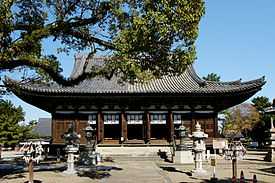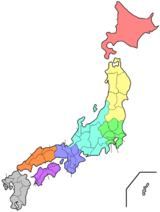Hyōgo Prefecture
| Hyōgo Prefecture 兵庫県 | ||
|---|---|---|
| Prefecture | ||
| Japanese transcription(s) | ||
| • Japanese | 兵庫県 | |
| • Rōmaji | Hyōgo-ken | |
| ||
 | ||
| Country | Japan | |
| Region | Kansai | |
| Island | Honshu | |
| Capital | Kobe | |
| Government | ||
| • Governor | Toshizo Ido | |
| Area | ||
| • Total | 8,396.13 km2 (3,241.76 sq mi) | |
| Area rank | 12th | |
| Population (November 1, 2011) | ||
| • Total | 5,582,978 | |
| • Rank | 7th | |
| • Density | 660/km2 (1,700/sq mi) | |
| ISO 3166 code | JP-28 | |
| Districts | 8 | |
| Municipalities | 41 | |
| Flower | Nojigiku (Chrysanthemum japonense) | |
| Tree | Camphor tree (Cinnamomum camphora) | |
| Bird | Oriental White Stork (Ciconia boyciana) | |
| Website |
web | |
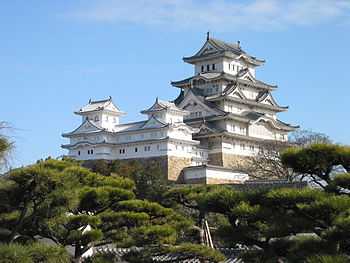
Hyōgo Prefecture (兵庫県 Hyōgo-ken) is a prefecture of Japan located in the Kansai region on Honshu island.[1] The capital is Kobe.[2]
The prefecture's name was previously alternately spelled as Hiogo.
History
Present-day Hyōgo Prefecture includes the former provinces of Harima, Tajima, Awaji, and parts of Tamba and Settsu.[3]
In 1180, near the end of the Heian Period, Emperor Antoku, Taira no Kiyomori, and the Imperial court moved briefly to Fukuhara, in what is now the city of Kobe. There the capital remained for five months.
Himeji Castle, a UNESCO World Heritage Site, is in the city of Himeji.
Southern Hyōgo Prefecture was severely devastated by the magnitude 7.2 Great Hanshin earthquake of 1995, which destroyed major parts of Kobe and Awaji, as well as Takarazuka and neighboring Osaka Prefecture, killing nearly 6,500 people.
Geography




Hyōgo has coastlines on two seas: to the north, the Sea of Japan, to the south, the Seto Inland Sea. The northern portion is sparsely populated, except for the city of Toyooka, and the central highlands are only populated by tiny villages. Most of Hyōgo's population lives on the southern coast, which is part of the Osaka-Kobe-Kyoto metropolitan area. Awaji Island is an island that separates the Inland Sea and Osaka Bay, lying between Honshu and Shikoku.
Summertime weather throughout Hyōgo is hot and humid. As for winter conditions in Hyōgo, the north of Hyōgo tends to receive abundant snow, whilst the south receives only the occasional flurry.
Hyōgo borders on Osaka Prefecture, Kyoto Prefecture, Tottori Prefecture and Okayama Prefecture.
As of March 31, 2008, 20% of the total land area of the prefecture was designated as Natural Parks, namely the Sanin Kaigan and Setonaikai National Parks; Hyōnosen-Ushiroyama-Nagisan Quasi-National Park; and Asago Gunzan, Harima Chūbu Kyūryō, Inagawa Keikoku, Izushi-Itoi, Kasagatayama-Sengamine, Kiyomizu-Tōjōko-Tachikui, Onzui-Chikusa, Seiban Kyūryō, Seppiko-Mineyama, Tajima Sangaku, and Taki Renzan Prefectural Natural Parks.[4]
Cities
Twenty-nine cities are located in Hyōgo Prefecture:
- Kobe is where the Hyogo Prefectural Government sits.
|
Towns
These are the towns in each district:
Islands
Two major artificial islands are located Hyōgo Prefecture:
- Rokko Island
- Port Island
National parks
-
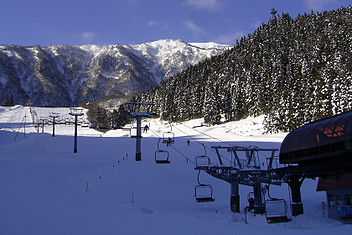
Hyōnosen-Ushiroyama-Nagisan Quasi-National Park (Mt. Hyonosen view from Yabu)
-

Hyōnosen-Ushiroyama-Nagisan Quasi-National Park (Torokawataira in Kami)
-

Sanin Kaigan National Park (Takeno Beach in Toyooka)
-

Sanin Kaigan National Park (Tajima-mihonoura of Sanin Coast in Shinonsen)
Mergers
Future mergers
The city of Akō and the only town in Akō District (Kamigōri), were scheduled to merge and the city would still retain the name Akō. Akō District would be defunct if the merger was successful.[5] However, the merger hasn't taken place.
Economy
Hyōgo Prefecture has many heavy industries, metal and medical, and Kobe Port is one of the largest ports in Japan.
Hyōgo is a part of the Hanshin Industrial Region. There are two research institute of Riken, natural sciences research institute in Japan, in Kobe and Harima. It has "SPring-8",a synchrotron radiation facility in Harima.
Culture
National Treasures of Japan
- Himeji Castle in Himeji (UNESCO World Heritage Site)
- Jōdo-ji in Ono
- Ichijō-ji in Kasai
- Kakurin-ji in Kakogawa
- Taisan-ji in Kobe
- Chōkō-ji in Katō
-

Ichijo-ji in Kasai
Important Preservation Districts for Groups of Historic Buildings in Japan
- Kitano-chō Yamamoto-dōri
- Izushi
- Sasayama
-

Kitano-chō Yamamoto-dōri
-

Izushi
-

Sasayama
Museums
- Hyōgo Prefectural Museum of Art in Nada Ward, Kobe.
- Kobe City Museum in Chuo Ward, Kobe.
- Kobe Maritime Museum in Chuo Ward, Kobe.
- Himeji City Museum of Art in Himeji.
- Asago Art Village in Asago.
- Ashiya City Museum of Art & History in Ashiya.
-
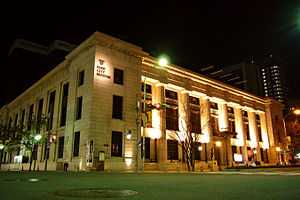
Kobe City Museum in Kobe.
Education
Universities
Amagasaki
- Sonoda Women's University
- St. Thomas University (Eichi University)
Takarazuka
Sanda
- Kwansei Gakuin University (Sanda Campus)
Nishinomiya
- Kwansei Gakuin University
- Otemae University
- Mukogawa Women's University
Ashiya
Kobe
- Kobe University
- Kobe University of Commerce
- Kobe Gakuin University
- Kobe City University of Foreign Studies
- Kobe Women's University
- Kobe Shukugawa Gakuin University
- Konan University
- University of Marketing and Distribution Sciences
- University of Hyogo
Kato
Akashi
Kakogawa
Himeji
- Himeji Institute of Technology
- Himeji Dokkyo University
- Himeji Kinki University
- University of Hyogo
Akō
High schools
There are 163 public and 52 private high schools within Hyogo prefecture. Of the public high schools, some are administered by the Hyogo prefectural government, whilst the others are administered by local municipalities.
Sports
The sports teams listed below are based in Hyōgo.
Football (soccer)
- Vissel Kobe (Kobe)
- INAC Kobe Leonessa (Women's) (Kobe)
Baseball
- Orix Buffaloes (Kobe)
- Hanshin Tigers (Nishinomiya)
Volleyball
- Hisamitsu Springs (Kobe)
- JT Marvelous (NIshinomiya)
Rugby
- Kobe Steel Kobelco Steelers (Kobe)
- World Fighting Bull (Kobe)
Basketball
- Hyogo Storks (Kobe)
Tourism
Hyogo Prefecture enjoys a beautiful expanse of land, stretching from the North Coast with natural ohnsens and seafood delicacies, gentle inland mountains and valleys with world-famous Izushi Soba,[6] to Awaji Island in the Inland Sea to the south. Serviced by two international airports, five shinkansen stations, and several ferry ports, and an excellent railway and road network, Hyogo is very convenient for foreign and domestic tourists alike. Historic villages and towns abound in Hyogo, which boasts the "Maccu Piccu of Japan", the ruins of an early Castle set atop a mountain range, seemingly floating on the clouds.[7] Many younger tourists prefer the urban mainstream tourism, for which Kobe city remains very attractive, with its shopping centres, "Harbourland", and the world`s fastest supercomputer.
Kobe city remains a popular tourist destination. The region symbolizes Japan's earliest contact with the outside world. Many homes of early foreign merchants stand on the bluff overlooking the harbor. The vista of Osaka Bay remains a "million-dollar view".
A popular troupe of Takarazuka Revue plays in Takarazuka.
The north of Hyogo Prefecture has sightseeing spots such as Kinosaki Onsen, Izushi, and Yumura Onsen, and the Matsuba Crab,and Tajima Beef are both national delicacies.[8]
-

million-dollar view, Kobe
-
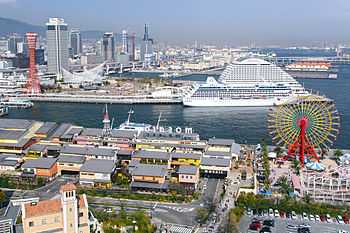
Harborland - Meriken Park area in Kobe
-

Awaji Yumebutai in Awaji
-

Kuchiganaya in Asago
-

Kinosaki Onsen
-
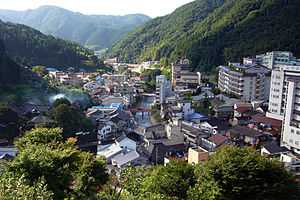
Yumura Onsen
-

Tonomine highland in Kamikawa
-

Toyooka Stork Park
Festival and events

- Miyuki Street New Year's midnight traditional sale, Himeji
- Nishinomiya Shrine's Ebisu Festival in January
- Yanagihara Ebisu Festival in January, Kobe
- Tada Shrine's Genji Festival in April, Kawanishi
- Kobe Festival and Parade in May
- Aioi Peron Festival in May
- Himeji Yukata Festival in June
- Dekansho Bon Dancing Festival in August, Sasayama
- Nada Fighting Festival, Himeji
- Kobe Luminarie in December
- Ako Chushingura Parade
Transportation
Rail
- JR West
- Sanyo Shinkansen
- JR Kobe Line
- Wadamisaki Line
- Sanyo Main Line
- Sanin Line
- Fukuchiyama Line (JR Takarazuka Line)
- Kakogawa Line
- Bantan Line
- Kishin Line
- Ako Line
- Hankyu Railway
- Kobe Line
- Kobe Kosoku Line
- Itami Line
- Imazu Line
- Koyo Line
- Takarazuka Line
- Nose Railway
- Myoken Line
- Nissei Line
- Shintetsu
- Arima Line
- Kobe Kosoku Line
- Sanda Line
- Koen Toshi Line
- Ao Line
- Hokushin Kyuko Railway
- Hojo Railway (Ao-Hojo)
- Hanshin Railway
- Main Line
- Kobe Kosoku Line
- Mukogawa Line
- Hanshin Nanba Line
- Sanyo Railway
- Main Line
- Aboshi Line
People movers
- Kobe New Transit
- Port Liner
- Rokko Liner
Road
Expressways
- Chugoku Expressway
- Sanyo Expressway
- Kobe-Awaji-Naruto Expressway
- Meishin Expressway
- Maizuru-Wakasa Expressway
- Bantan Expressway
- Second Shinmei road
- Hanshin Expressway
National highways
- Route 2
- Route 9
- Route 28
- Route 29
- Route 43
- Route 171
- Route 173
- Route 174 (Sannomiya-Kobe Port)
- Route 175
- Route 176
- Route 178
- Route 179
- Route 250
- Route 312
- Route 372
- Route 373
- Route 426
- Route 427
- Route 428
- Route 429
- Route 436
- Route 477
- Route 482
- Route 483
Ports
- Kobe Port - Mainly international container hub port
- Akashi Port
- Shikama Port - Mainly Shodo Island route ferry
Airport
Notable people
- Ume Aoki, manga artist
- Mana Ashida, child actress from Nishinomiya
- Koichi Domoto, singer of Kinki Kids
- Heath, musician, singer-songwriter and bassist of X Japan is from Amagasaki
- Miracle Hikaru, comedian and impersonator is from Toyooka
- Kanō Jigorō, founder of the martial art Judo
- Jun, musician, singer-songwriter and guitarist of Phantasmagoria is from Kobe
- Shinji Kagawa, footballer from Kobe
- Tomoya Kanki, drummer of One Ok Rock
- Tomomi Ogawa, bassist of SCANDAL
- Kaoru, guitarist of Dir en grey
- Ayaka Kimura, actress, former singer of Coconuts Musume is from Kobe
- Keiko Kitagawa, actress from Pretty Guardian Sailor Moon and Buzzer Beat was born in Kobe
- Miho Komatsu, singer and song-writer from Kobe
- Kamui Kobayashi, former Sauber and Toyota Racing driver from Amagasaki
- Chisa Maekawa, singer of Girl Next Door
- Kiyomatsu Matsubara, ichthyologist, herpetologist & marine biologist
- Aya Matsuura, singer is from Himeji
- Miyavi, musician, although born in Konohana-ku, Osaka grew up in Kawanishi
- Soyo Oka, musician from Nishinomiya
- Masamune Shirow, manga artist was born in Kobe
- So Taguchi, outfielder for the Chicago Cubs
- Masahiro Tanaka, pitcher for the New York Yankees
- Nagaru Tanigawa, creator of the Haruhi Suzumiya series was born in Kinki
- Fumito Ueda, videogame creator of Ico, Shadow of the Colossus, and The Last Guardian
- Juri Ueno, Japanese Academy Award-winning actress best known for her performances in Swing Girls and the live-action adaptation of Nodame Cantabile, is from Kakogawa
- Shota Yasuda, guitarist of Kanjani Eight is from Amagasaki
- Piko, musician, Vocaloid singer born in Kobe, Hyōgo
Sister state agreement with Western Australia
In 1981, a sister state agreement was drawn up between Hyogo and the state of Western Australia in Australia.[9] To commemorate the 10th anniversary of this agreement in 1992, the Hyogo Prefectural Government Cultural Centre was established in Perth.[10]
Notes
- ↑ Nussbaum, Louis-Frédéric. (2005). "Hyōgo prefecture" in Japan Encyclopedia, pp. 363-365, p. 363, at Google Books; "Kansai" in Japan Encyclopedia, p. 477, p. 477, at Google Books.
- ↑ Nussbaum, "Kobe" in Japan Encyclopedia, p. 537, p. 537, at Google Books.
- ↑ Nussbaum, "Provinces and prefectures" in Japan Encyclopedia, p. 780, p. 780, at Google Books.
- ↑ "General overview of area figures for Natural Parks by prefecture" (PDF). Ministry of the Environment. Retrieved 4 February 2012.
- ↑
- ↑ http://izushi-soba.com/
- ↑ http://www.city.asago.hyogo.jp/kankou/eng/TakedaCastle.html
- ↑ http://www.eg.jal.com/world/en/guidetojapan/detail/index.html?spot_code=matsubacrab
- ↑ http://www.perth.wa.gov.au/council/national-and-international-relations/sister-cities
- ↑ http://www.hyogo.com.au/centre_introduction.htm
References
- Nussbaum, Louis-Frédéric and Käthe Roth. (2005). Japan encyclopedia. Cambridge: Harvard University Press. 10-ISBN 0-674-01753-6; 13-ISBN 978-0-674-01753-5; OCLC 58053128
External links
| Wikimedia Commons has media related to Hyogo prefecture. |
- Official Hyōgo prefecture homepage
- Hyōgo prefecture tourist guide
- Hyōgo Business & Cultural Center
- Medical Services in Hyōgo prefecture
| ||||||||||||||||||||||||||||||||||||||||||||
| ||||||||||||||||||||||||||||||||||||||||||||||
Coordinates: 34°41′26.94″N 135°10′59.08″E / 34.6908167°N 135.1830778°E



